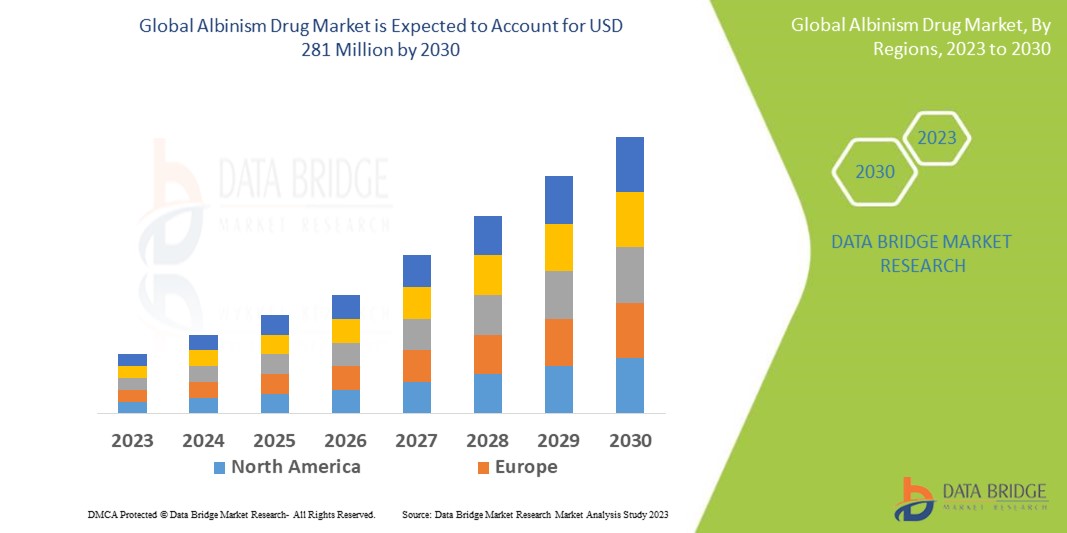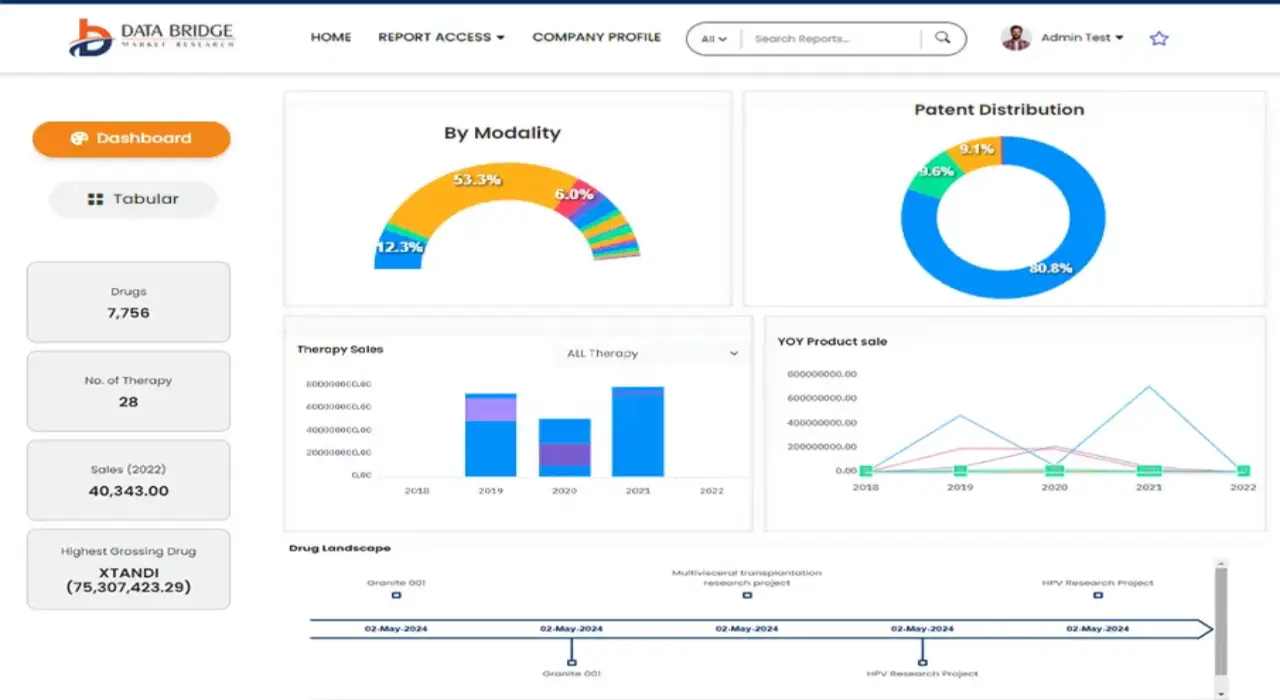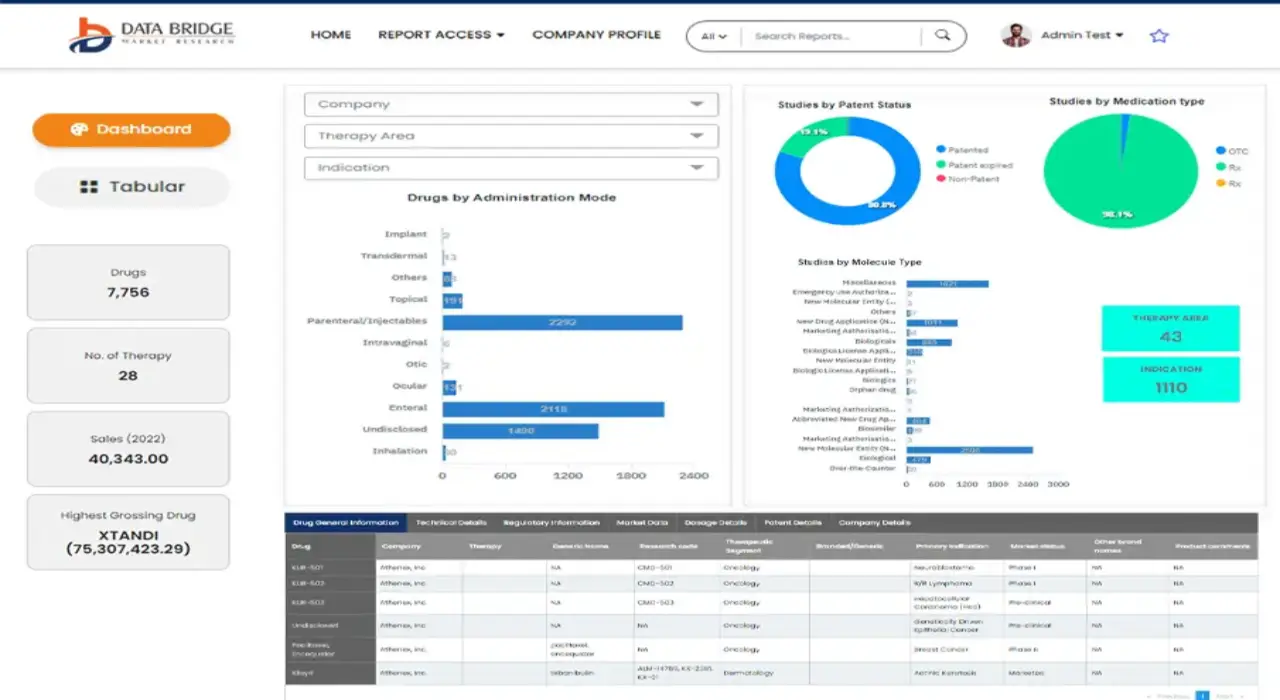Global Albinism Drug Market
Tamanho do mercado em biliões de dólares
CAGR :
% 
 USD
207.00 Million
USD
281.00 Million
2022
2030
USD
207.00 Million
USD
281.00 Million
2022
2030
| 2023 –2030 | |
| USD 207.00 Million | |
| USD 281.00 Million | |
|
|
|
|
Global Albinism Drug Market, By Type (Oculocutaneous Albinism, X-Linked Ocular Albinism, Hermansky-Pudlak Syndrome, Chediak-Higashi Syndrome), Treatment Type (Surgery, Drugs, Others), Distribution Channel (Online Pharmacy, Direct Tenders, Retailers, Others), End-Users (Hospitals, Homecare, Specialty Clinics, Others) - Industry Trends and Forecast to 2030.
Albinism Drug Market Analysis and Size
Albinism is an ultra-rare inherited genetic disorder characterized by reduced or no melanin pigments in the eyes, skin and hair. Melanin plays a critical role in the development of certain optical nerves. It occurs in all racial and ethnic groups worldwide. It is important for individuals who have albinism to protect their skin and eyes from the sun.
Data Bridge Market Research analyses that the albinism drug market was valued at USD 207 million in 2022 and is expected to reach the value of USD 281 million by the year 2030, at a CAGR of 5.4% during the forecast period. This indicates that the market value. “oculocutaneous albinism” dominates the type segment of the albinism drug market owing to the increasing awareness of albinism. In addition to the insights on market scenarios such as market value, growth rate, segmentation, geographical coverage, and major players, the market reports curated by the Data Bridge Market Research also include depth expert analysis, patient epidemiology, pipeline analysis, pricing analysis, and regulatory framework.
Albinism Drug Market Scope and Segmentation
|
Report Metric |
Details |
|
Forecast Period |
2023 to 2030 |
|
Base Year |
2022 |
|
Historic Years |
2021 (Customizable to 2015-2020) |
|
Quantitative Units |
Revenue in USD Million, Volumes in Units, Pricing in USD |
|
Segments Covered |
By Type (Oculocutaneous Albinism, X-Linked Ocular Albinism, Hermansky-Pudlak Syndrome, Chediak-Higashi Syndrome), Treatment Type (Surgery, Drugs, Others), Distribution Channel (Online Pharmacy, Direct Tenders, Retailers, Others), End-Users (Hospitals, Homecare, Specialty Clinics, Others), Country (U.S., Canada, Mexico, Peru, Brazil, Argentina, Rest of South America, Germany, Italy, U.K., France, Spain, Netherlands, Belgium, Switzerland, Turkey, Russia, Hungary, Lithuania, Austria, Ireland, Norway, Poland, Rest of Europe, Japan, China, India, South Korea, Australia, Singapore, Malaysia, Thailand, Indonesia, Philippines, Vietnam, Rest of Asia Pacific, South Africa, Saudi Arabia, U.A.E, Kuwait, Israel, Egypt, Rest of Middle East and Africa) |
|
Countries Covered |
U.S., Canada and Mexico in North America, Peru, Brazil, Argentina and Rest of South America as part of South America, Germany, Italy, U.K., France, Spain, Netherlands, Belgium, Switzerland, Turkey, Russia, Hungary, Lithuania, Austria, Ireland, Norway, Poland, Rest of Europe in Europe, Japan, China, India, South Korea, Australia, Singapore, Malaysia, Thailand, Indonesia, Philippines, Vietnam, Rest of Asia-Pacific (APAC) in Asia-Pacific (APAC), South Africa, Saudi Arabia, U.A.E, Kuwait, Israel, Egypt, Rest of Middle East and Africa (MEA) as a part of Middle East and Africa (MEA). |
|
Market Players Covered |
AbbVie Inc. (U.S.), Roche Holding AG (Switzerland), Novartis International AG (Switzerland), Johnson & Johnson (U.S.), Pfizer Inc. (U.S.), Merck & Co., Inc. (U.S.), Sanofi (France), AstraZeneca plc (U.K.), GlaxoSmithKline plc (U.K.), Bristol Myers Squibb Company (U.S.), Eli Lilly and Company (U.S.), Amgen Inc. (U.S.), Gilead Sciences, Inc. (U.S.), Takeda Pharmaceutical Company Limited (Japan), Bayer AG (Germany) among others. |
|
Market Opportunities |
|
Market Definition
From the name itself, it is clear that that albinism drug is used the technology, products, and services dedicated to addressing the symptoms and complications associated with albinism, a genetic disorder characterized by the absence or reduction of melanin pigment in the skin, hair, and eyes.
Albinism Drug Market Dynamics
Drivers
- Increasing Awareness of Albinism
The rising awareness about albinism among healthcare professionals, patients, and the general public is driving the demand for improved treatments and supportive care options. Increased awareness leads to early detection, diagnosis, and management of albinism. This in turn has carved the way for the growth of the market.
- Advancements in Genetic Research
Progress in genetic research and understanding the underlying causes of albinism are creating opportunities for the development of targeted therapies. Ongoing genetic studies and advancements in gene therapy techniques may lead to innovative treatments that address the specific genetic mutations associated with albinism. This demographic trend is expected to boost market growth.
- Supportive Care Products and Services
The demand for supportive care products and services for individuals with albinism, such as sunscreens, protective eyewear, and specialized skincare, is driving market growth. These products aim to minimize the risk of sunburn, skin cancer, and visual impairment, thus improving the overall well-being of individuals with albinism.
Opportunity
- Growing government initiatives
The government initiatives, schemes, or funding that support and promote the innovation and development of the albinism drug market provide growth opportunities for the market players in the forecast period of 2023 to 2030. Additionally, rising awareness of albinism, penetration rate, market expansion in developing countries, rise in the personalize and precise medicine globally and increasing per capita expenditure on health care will further expand the market's growth rate in the future.
Restrain/ Challenge
Limited Treatment Options
There is a lack of targeted drug therapies specifically designed for albinism. The limited availability of effective treatments for managing the symptoms and complications of albinism poses a restrain to the market's growth.
This albinism drug market report provides details of new recent developments, trade regulations, import-export analysis, production analysis, value chain optimization, market share, impact of domestic and localized market players, analyses opportunities in terms of emerging revenue pockets, changes in market regulations, strategic market growth analysis, market size, category market growths, application niches and dominance, product approvals, product launches, geographic expansions, technological innovations in the market. To gain more info on the Albinism Drug market contact Data Bridge Market Research for an Analyst Brief, our team will help you take an informed market decision to achieve market growth.
Recent Development
- In February 2019, A small pilot clinical study at the National Eye Institute (NEI) suggests that the drug nitisinone increases melanin production in some people with oculocutaneous albinism type 1B (OCA-1B), a rare genetic disease that causes pale skin and hair and poor vision.
Global Albinism Drug Market Scope
The albinism drug market is segmented on the basis of type, treatment type, end-users, and distribution channel. The growth amongst these segments will help you analyse meagre growth segments in the industries and provide the users with a valuable market overview and market insights to help them make strategic decisions for identifying core market applications.
Type
- Oculocutaneous Albinism
- X-Linked Ocular Albinism
- Hermansky-Pudlak Syndrome
- Chediak-Higashi Syndrome
Treatment Type
- Surgery
- Drugs
- Others
End User
- Hospitals
- Homecare
- Specialty Clinics
- Others
Distribution Channel
- Direct Sales
- Retailers
- Online Retailers
- Others
Albinism Drug Market Regional Analysis/Insights
The albinism drug market is analysed and market size insights and trends are provided by country, type, treatment type, end-users, and distribution channel as referenced above.
The countries covered in the albinism drug market report are U.S., Canada and Mexico in North America, Peru, Brazil, Argentina and Rest of South America as part of South America, Germany, Italy, U.K., France, Spain, Netherlands, Belgium, Switzerland, Turkey, Russia, Hungary, Lithuania, Austria, Ireland, Norway, Poland, Rest of Europe in Europe, Japan, China, India, South Korea, Australia, Singapore, Malaysia, Thailand, Indonesia, Philippines, Vietnam, Rest of Asia-Pacific (APAC) in Asia-Pacific (APAC), South Africa, Saudi Arabia, U.A.E, Kuwait, Israel, Egypt, Rest of Middle East and Africa (MEA) as a part of Middle East and Africa (MEA).
North America dominates the albinism drug market due to a rise in the introduction of certain toxins which interrupt the histological features of melanin and increase in the awareness of albinism in this region.
Asia-Pacific is expected to witness significant growth due to the increase in government initiatives to promote awareness, rise in medical tourism, growing research activities in the region, availability of massive untapped markets, large population pool, and the growing demand for quality healthcare in the region
The country section of the report also provides individual market impacting factors and changes in regulation in the market domestically that impacts the current and future trends of the market. Data points like down-stream and upstream value chain analysis, technical trends and porter's five forces analysis, case studies are some of the pointers used to forecast the market scenario for individual countries. Also, the presence and availability of global brands and their challenges faced due to large or scarce competition from local and domestic brands, impact of domestic tariffs and trade routes are considered while providing forecast analysis of the country data.
Healthcare Infrastructure Growth Installed base and New Technology Penetration
The albinism drug market also provides you with detailed market analysis for every country growth in healthcare expenditure for capital equipment, installed base of different kind of products for albinism drug market, impact of technology using life line curves and changes in healthcare regulatory scenarios and their impact on the Albinism Drug market. The data is available for historic period 2010-2021.
Competitive Landscape and Albinism Drug Market Share Analysis
The albinism drug market competitive landscape provides details by competitor. Details included are company overview, company financials, revenue generated, market potential, investment in research and development, new market initiatives, global presence, production sites and facilities, production capacities, company strengths and weaknesses, product launch, product width and breadth, application dominance. The above data points provided are only related to the companies' focus related to albinism drug market.
Some of the major players operating in the albinism drug market are:
- AbbVie Inc. (U.S.)
- Roche Holding AG (Switzerland)
- Novartis International AG (Switzerland)
- Johnson & Johnson (U.S.)
- Pfizer Inc. (U.S.)
- Merck & Co., Inc. (U.S.)
- Sanofi (France)
- AstraZeneca plc (U.K.)
- GlaxoSmithKline plc (U.K.)
- Bristol Myers Squibb Company (U.S.)
- Eli Lilly and Company (U.S.)
- Amgen Inc. (U.S.)
- Gilead Sciences, Inc. (U.S.)
- Takeda Pharmaceutical Company Limited (Japan)
- Bayer AG (Germany)
SKU-
Obtenha acesso online ao relatório sobre a primeira nuvem de inteligência de mercado do mundo
- Painel interativo de análise de dados
- Painel de análise da empresa para oportunidades de elevado potencial de crescimento
- Acesso de analista de pesquisa para personalização e customização. consultas
- Análise da concorrência com painel interativo
- Últimas notícias, atualizações e atualizações Análise de tendências
- Aproveite o poder da análise de benchmark para um rastreio abrangente da concorrência
Metodologia de Investigação
A recolha de dados e a análise do ano base são feitas através de módulos de recolha de dados com amostras grandes. A etapa inclui a obtenção de informações de mercado ou dados relacionados através de diversas fontes e estratégias. Inclui examinar e planear antecipadamente todos os dados adquiridos no passado. Da mesma forma, envolve o exame de inconsistências de informação observadas em diferentes fontes de informação. Os dados de mercado são analisados e estimados utilizando modelos estatísticos e coerentes de mercado. Além disso, a análise da quota de mercado e a análise das principais tendências são os principais fatores de sucesso no relatório de mercado. Para saber mais, solicite uma chamada de analista ou abra a sua consulta.
A principal metodologia de investigação utilizada pela equipa de investigação do DBMR é a triangulação de dados que envolve a mineração de dados, a análise do impacto das variáveis de dados no mercado e a validação primária (especialista do setor). Os modelos de dados incluem grelha de posicionamento de fornecedores, análise da linha de tempo do mercado, visão geral e guia de mercado, grelha de posicionamento da empresa, análise de patentes, análise de preços, análise da quota de mercado da empresa, normas de medição, análise global versus regional e de participação dos fornecedores. Para saber mais sobre a metodologia de investigação, faça uma consulta para falar com os nossos especialistas do setor.
Personalização disponível
A Data Bridge Market Research é líder em investigação formativa avançada. Orgulhamo-nos de servir os nossos clientes novos e existentes com dados e análises que correspondem e atendem aos seus objetivos. O relatório pode ser personalizado para incluir análise de tendências de preços de marcas-alvo, compreensão do mercado para países adicionais (solicite a lista de países), dados de resultados de ensaios clínicos, revisão de literatura, mercado remodelado e análise de base de produtos . A análise de mercado dos concorrentes-alvo pode ser analisada desde análises baseadas em tecnologia até estratégias de carteira de mercado. Podemos adicionar quantos concorrentes necessitar de dados no formato e estilo de dados que procura. A nossa equipa de analistas também pode fornecer dados em tabelas dinâmicas de ficheiros Excel em bruto (livro de factos) ou pode ajudá-lo a criar apresentações a partir dos conjuntos de dados disponíveis no relatório.














